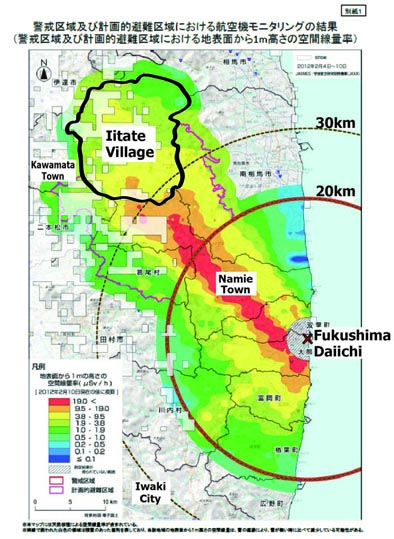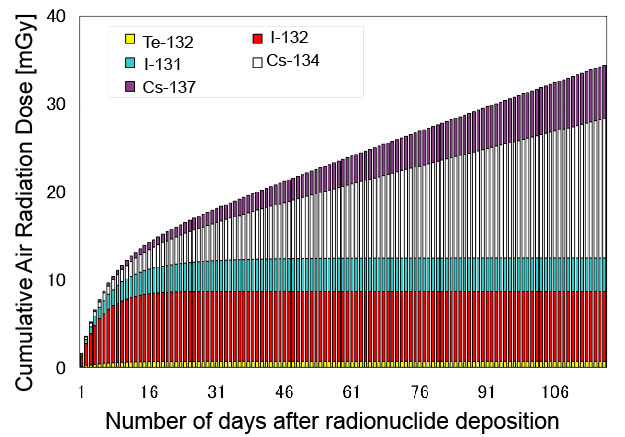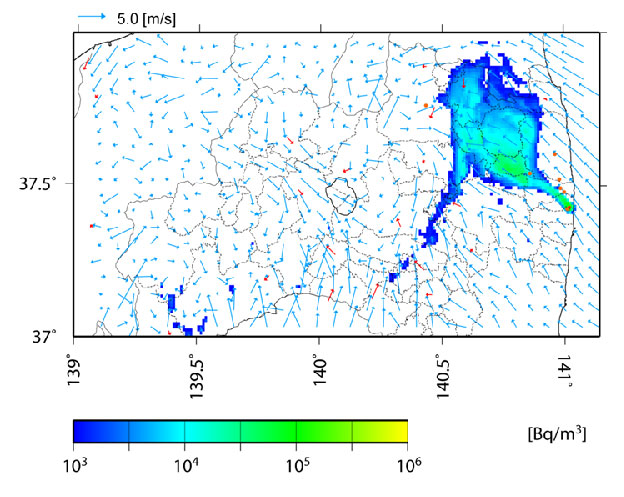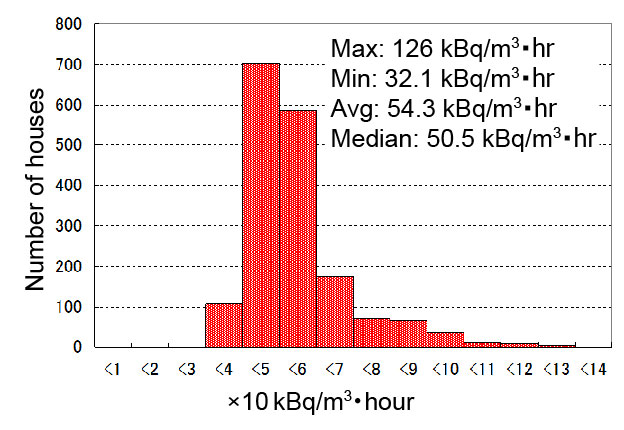Highly contaminated areas outside the 20-km zone, such as Iitate Village, were designated as planned evacuation zones on April 22, 2011 and most of the residents had evacuated from the village within two months following that. The Japanese government has not estimated on its own responsibility how great a radiation dose those who evacuated immediately after the accident and those who stayed in contaminated areas, such as Iitate, for some time, were exposed to. The results of calculations from the System for Prediction of Environmental Emergency Dose Information (SPEEDI), administered by the Nuclear Safety Technology Center, an affiliate of the Ministry of Education, Culture, Sports, Science and Technology, were published for the first time on March 23, 2011. According to an instruction from the now liquidated Nuclear Safety Commission (NSC), which was concerned about children’s thyroid exposure, 1,080 children in Iwaki City, Kawamata Town, and Iitate Village, all located in Fukushima Prefecture, were given a thyroid monitoring test between March 26 and 30. Their thyroid radiation dose was measured with a radiation survey meter placed on their throat. The report prepared by the NSC states that no child had a thyroid dose rate in excess of 0.2 μSv/h, which was equivalent to a thyroid dose of 100 mSv, and that 55% of the total number of children showed 0 μSv/h, and 26%, 0.01 μSv/h. When this test was conducted, we were in Iitate for the survey. The radiation dose rates in the vicinity of Iitate municipal hall were 5 to 7 μSv/h, and the dose rates inside the concrete structure of the hall were about 0.5 μSv/h. It is a mystery to me how they could precisely measure 0.01 μSv/h under such conditions in the village. Early-stage exposure estimation yet insufficient It is common knowledge among radiation workers that during a short period of time immediately after a nuclear accident, the greatest attention should be paid to exposure to radioiodine, especially the exposure of children’s thyroids to I-131 (with a half-life of eight days). Why thyroid monitoring was not performed on a large scale before the I-131 physically disappeared is another mystery to me. (After the Chernobyl accident, data on a total of 400,000 cases, including 200,000 in Belarus, 150,000 in Ukraine, and 50,000 in Russia, was collected by thyroid monitoring, the data then being used to estimate thyroid radiation dose.) “Regarding the evaluation of radiation doses received by residents, Fukushima Prefecture will hereafter conduct surveys in target areas...and will estimate and evaluate the radiation dose received by each resident” writes the Fukushima accident report the Japanese government submitted to the International Atomic Energy Agency (IAEA) in June 2011. “There are estimated to be about 2 million residents of Fukushima Prefecture to be surveyed and the survey would be conducted as part of the health management survey of Fukushima Prefecture.” This indicates that the national government has entirely passed responsibility for early-stage exposure estimation to the prefectural survey organizers. The Fukushima Health Management Survey is overseen by the study committee of an expert commission headed by Dr. Shunichi Yamashita. The committee has been criticized for its exclusiveness and opaqueness. The Survey includes the dose estimation of residents, and the survey for this estimation is called the basic survey. The basic survey is conducted in the form of a questionnaire, in which residents are expected to write down their activities at the time of the Fukushima accident. Each resident’s external dose is then estimated based on the written responses in the questionnaire form (thyroid exposure to radioiodine is outside the scope of this survey). As of January 31, 2013, the average retrieval rate of the completed basic survey forms from the population across the prefecture was 23.2%. The rate was 56.7% in areas where the survey was started earlier, which include Namie Town, Iitate Village and part of Kawamata Town. As of January 25 last year, the rates were 20.8% and 50.2%, respectively. Although the prefecture has been actively encouraging the population to turn in the questionnaire through prefectural public relations efforts and newspapers, the increase in the rates since one year ago is not impressive. Dr. Shunichi Yamashita and his group entered Fukushima before we went to Iitate for the survey. It is well known that they toured the prefecture repeating the notion that “Radioactive exposure is nothing to worry about.” As a result, many people were needlessly exposed to radiation that could have otherwise been avoided. Dr. Yamashita and his team became extremely notorious among the Iitate villagers I know of. I assume that the low retrieval rates for the questionnaire can be attributed to people’s lack of confidence in the Fukushima Health Management Survey. According to the report of the Fukushima Health Management Survey released on February 13, 2013, the external exposure dose of 3,106 Iitate villagers (about half the total population of the village) during the four months (from March 11 to July 11) from the occurrence of the accident was: less than 3 mSv, 49%; less than 5 mSv, 75%; and less than 10 mSv, 98%. The average dose was not indicated, but I calculated it using my own method based on this dose distribution and obtained an average of 3.6 mSv. The estimation of external exposure dose based on the basic survey data is farmed out to the National Institute of Radiological Sciences but the details of the estimation method have not been made public. An independent attempt to estimate early-stage exposure dose In August 2012, Japan’s Cabinet Office Nuclear Emergency Response Headquarters launched a new research grant project named “Research and Survey Project on the Influence of Radiation on Health” and put out a public call for research applications. Because I am involved in the survey of radioactive contamination in Iitate Village, and because dose evaluation is one of my specialties, I had been hoping, if there were an opportunity, to conduct my own estimate of the early-stage dose of Iitate villagers. I decided to apply for the project and quickly formed a research team, which includes myself as representative, Dr. Nobuhiro Sawano (Kanazawa Seiryo University), and six other co-researchers. I named the research plan “Research on Evaluation of Early-stage Exposure Dose of Iitate Village Residents after the Fukushima Daiichi Accident.” Fortunately, the application was accepted. (About 14 million yen was granted. The project office has now been shifted from the Cabinet Office to the Ministry of the Environment.) Since November 2012, the entire team has worked enthusiastically, including the company we requested to carry out a simulation of atmospheric diffusion. We gave a presentation on the grant research at the “Research Achievements Report Meeting” on February 6, 2013, in Tokyo, to explain our achievements during FY2012. I would like to summarize the achievements the team has made thus far.
When the Fukushima Daiichi accident occurred, Iitate had a population of about 6,200 in about 1,700 households. Using commercially available household maps, telephone directories, the Japanese Geographical Survey Institute’s 1/25,000 maps, and Yahoo’s address to coordinates (longitude and latitude) transformation function, we determined the geographical coordinates of every household in Iitate. Step 2: Creation of a detailed Cs-137 deposition map based on data collected by the U.S. Department of Energy Co-researcher Dr. Sawano is a specialist in the geographic information system (GIS). When the Fukushima nuclear accident occurred, the U.S. Department of Energy’s National Nuclear Security Administration (NNSA) sent a large-scale radiation measurement team to U.S. military bases in Japan, and performed an airborne radiation survey using helicopters and aircraft (Figure 1). The survey data are published on the NNSA website. Based on this data, Dr. Sawano created a cesium deposition map of Iitate Village (Figure 2). Based on the contamination map, we obtained the distribution of Cs-137 deposition at 1,768 locations in Iitate Village (Figure 3). Step 3: Estimation of cumulative air dose per unit of Cs-137 deposition Figure 4 shows the cumulative external dose a person is exposed to after Cs-137 of 1 MBq/m2 (million becquerels per square meter) is deposited on the ground. To calculate the contribution of radionuclides other than Cs-137, we used five soil samples collected during the on-site Iitate survey in March 2011, using the averages obtained to calculate the contribution of these other radionuclides. Supposing that the radionuclides were deposited at one time, on the evening of March 15, 2011, and that residents stayed outdoors until they evacuated on June 30, calculated from the Cs-137 deposition, the cumulative air dose was 32.6 mGy per MBq/m2. When 0.8 is used as the Gray-to-Sievert conversion factor, 0.4 as the wooden house shielding factor, and a person is assumed to have spent eight hours a day in outdoor activities, one Iitate villager’s external dose was on average 14 mSv, a maximum of 37 mSv, and a minimum of 1.8 mSv, based on the cesium distribution shown in Figure 3. Step 4: Atmospheric diffusion simulation We commissioned Visual Information Services, which had been calculating its own atmospheric diffusion simulation and publishing the findings on its website, to simulate air diffusion around Iitate Village. Figure 5 shows the I-131 concentration in the surface atmosphere across Fukushima Prefecture on the evening of March 15, 2011. Figure 6 shows the distribution of cumulative I-131 concentration in the air for each house in Iitate. Supposing a one-year-old (with a respiration rate of 0.31 m3/h and a thyroid equivalent dose conversion coefficient of 1.4 × 10-3 mSv/Bq) was outdoors all the time, the one-year-old’s thyroid dose would be on average 24 mSv, a maximum of 55 mSv, and a minimum of 14 mSv. For details, please refer to our paper (in Japanese) at the following address: http://www.rri.kyoto-u.ac.jp/NSRG/ISPa.pdf From April 2013, we intend to interview Iitate villagers about their activities at the time to determine more precise dose estimates. Return to Radiaion Exposure page Return to NIT 153 contents 
|







